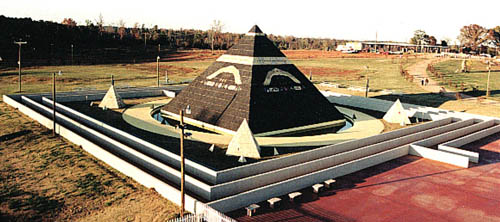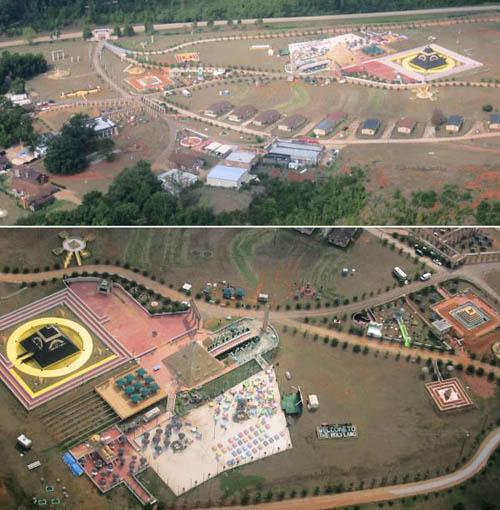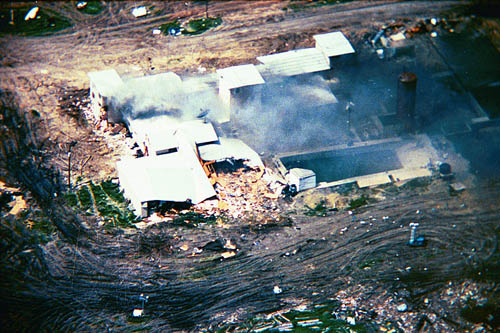
[Image: The black pyramid at Tama-Re, the Egypt of the West].
After watching a documentary about Ted Kaczynski—the Unabomber—I started looking into the supermax prison where Kaczynski is currently being held in the mountains of Colorado. And there have been a lot of bizarre people incarcerated there, including Andrew Fastow, former Chief Financial Officer of Enron, and Charles Harrelson, the (now deceased) hitman father of actor Woody Harrelson.
One of the inmates who particularly stood out, however, was Dwight York. York is “an author, black supremacist leader, musician, and convicted child molester,” Wikipedia tells us, and he built a colorful, Ancient Egyptian-themed instant city on several hundred acres of forest land in the U.S. state of Georgia.

[Image: Tama-Re photographed from above, via Wikimapia].
The Urban Dictionary’s description of Tama-Re is amazing; it reads like every race-based fear of the white U.S. middle class summed up in one surreal location.
When York and his Nuwaubians moved there and began erecting pyramids and obelisks there was much curiosity about the group. However trouble started when the citizens became aware of the fact that York was an ex-Black Panther and a convicted felon and statutory rapist who was preaching the gospel that whites were mutants and were inferior to blacks. There is also a foam rubber alien on display in the compound that causes problems with public relations. Officials have had problems with the Nuwaubians failing to comply with zoning and building permits that coincide with what they have created. The Nuwaubians feel that this is a racist attack.
It’s hard to top a “foam rubber alien,” but the fear-factor nonetheless gets ratcheted up a notch:
Many children from upper middle class cities have left college to live in poverty at the cult’s compound, Tama Re. This has caused a lot of turmoil in the lives of many families who can’t accept the fact that their sons and daughters have left them to follow an alien messiah. Throughout the grounds speakers everywhere emit the humming sound of Egyptian chants 24 hours a day. Inside one of the pyramids you can buy books and clothes as well as a Dr. York doll. The people who live on the land dwell in a trailer park full of double-wides. York claims his people are Moors who traveled by foot from Africa to what is currently Georgia before the continental drift. The only problem with this “indisputable” fact is that the moors were Muslims who existed way after the birth of Christ which was only approximately 2000 years ago.
Ergo, there was no way in plate tectonics that they could have walked all the way to Georgia.
In June 2005, after the compound’s governmental seizure, financial forfeiture, and ensuing sale for $1.1 million, outright demolition began. As the Atlanta Journal-Constitution reported at the time, the local sheriff was on the scene, “speaking with relish as he watched crews tear through the series of obelisks, statues, arches and buildings. Many of the dozens of structures were weathered and in disrepair. He said very few of the Egyptian structures or objects were worth salvaging. ‘It feels good to tear down the SOB myself,’ he said. ‘By the middle of next week, there will be nothing but a couple of pyramids.'”
How, though, could these sorts of messianic compounds be addressed by and incorporated into architectural discourse? How do tacky black pyramids full of Luxor references complexify or contradict something like Venturi & Scott-Brown’s ideas of pop cultural ornament discussed just this past weekend at Yale?
Put another way, when will religious compounds find a journalist willing to travel around the world writing an architectural history of these fringe religious environments and stylistically eccentric cult enclaves?
These are sites built such that their every spatial detail is not justified by some historically rigorous academic architectural code, but because they function, psychologically, as a piece-by-piece tuning of the built environment. Add enough ornamental references together, these spaces say, and some weird new Messiah might yet someday return. It is functional ornament.

[Image: The ashes of the David Koresh compound in Waco, Texas].
Of course, I’m fascinated by the idea that Tehran, for instance, has been analyzed by Mahmoud Ahmadinejad—who trained as a traffic engineer—for its ability to handle the crush of cars and pedestrians that will show up to greet the returning Messiah. And, spatially speaking, I would love to read more about the now-destroyed Texas farmhouse inside of which David Koresh once preached his Branch Davidian gospel. But what about the central headquarters of Aum Shinrikyo, where LSD-fueled physicists meditated in the dark, crowned with well-lit helmets of electrodes, or the mirrored room inside of which Heaven’s Gate cultists once strangled themselves out of fear of Hale-Bopp?
Somewhere between Spaced Out, Survival City, and Gomorrah, a seriously amazing book about the architectural design of religious compounds is waiting to be written.